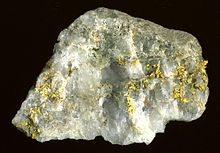
Various theories of ore genesis explain how the various types of mineral deposits form within Earth's crust. Ore-genesis theories vary depending on the mineral or commodity examined.
Ore-genesis theories generally involve three components: source, transport or conduit, and trap. (This also applies to the petroleum industry: petroleum geologists originated this analysis.)
- Source is required because metal must come from somewhere, and be liberated by some process.
- Transport is required first to move the metal-bearing fluids or solid minerals into their current position, and refers to the act of physically moving the metal, as well as to chemical or physical phenomena which encourage movement.
- Trapping is required to concentrate the metal via some physical, chemical, or geological mechanism into a concentration which forms mineable ore.
The biggest deposits form when the source is large, the transport mechanism is efficient, and the trap is active and ready at the right time.
© MMXXIII Rich X Search. We shall prevail. All rights reserved. Rich X Search
